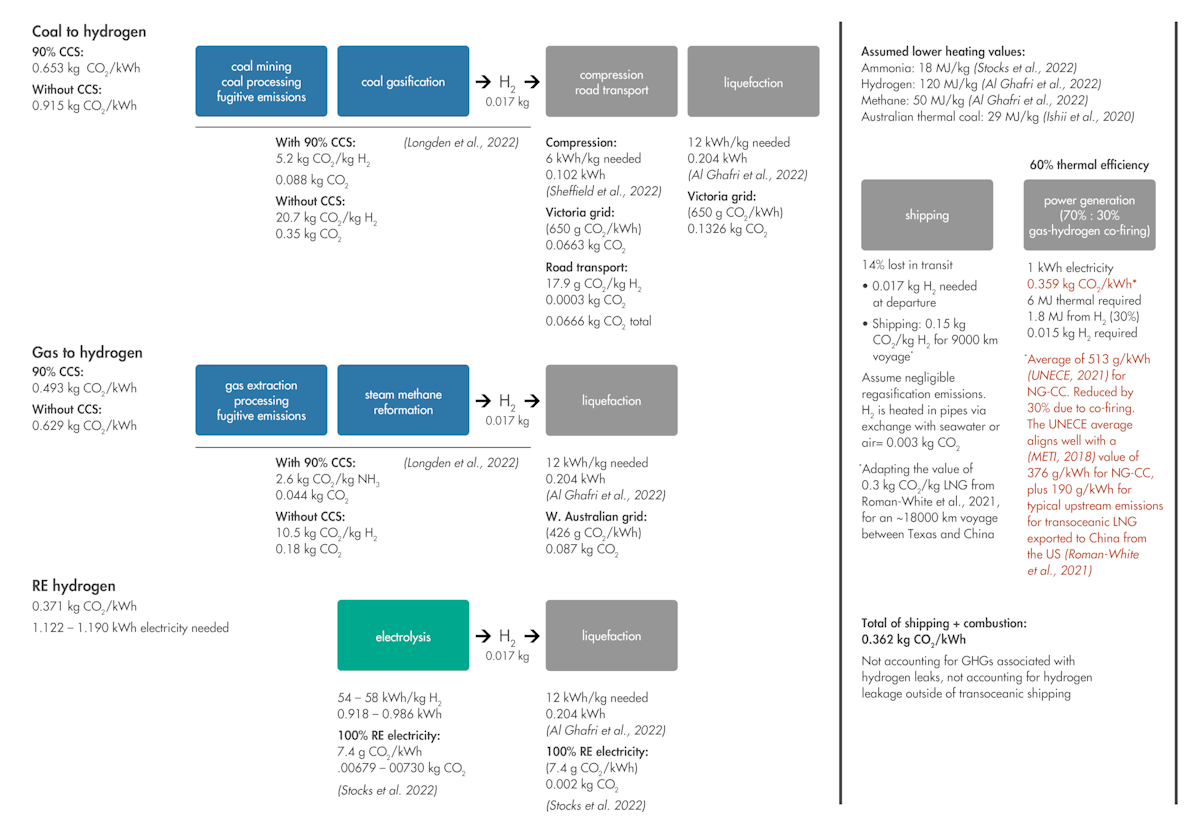Critiquing Asia’s Hydrogen Power Ambitions
Policy recommendations and guiding principles for redesigning national hydrogen policies for greater efficiency, practicality, and sustainability
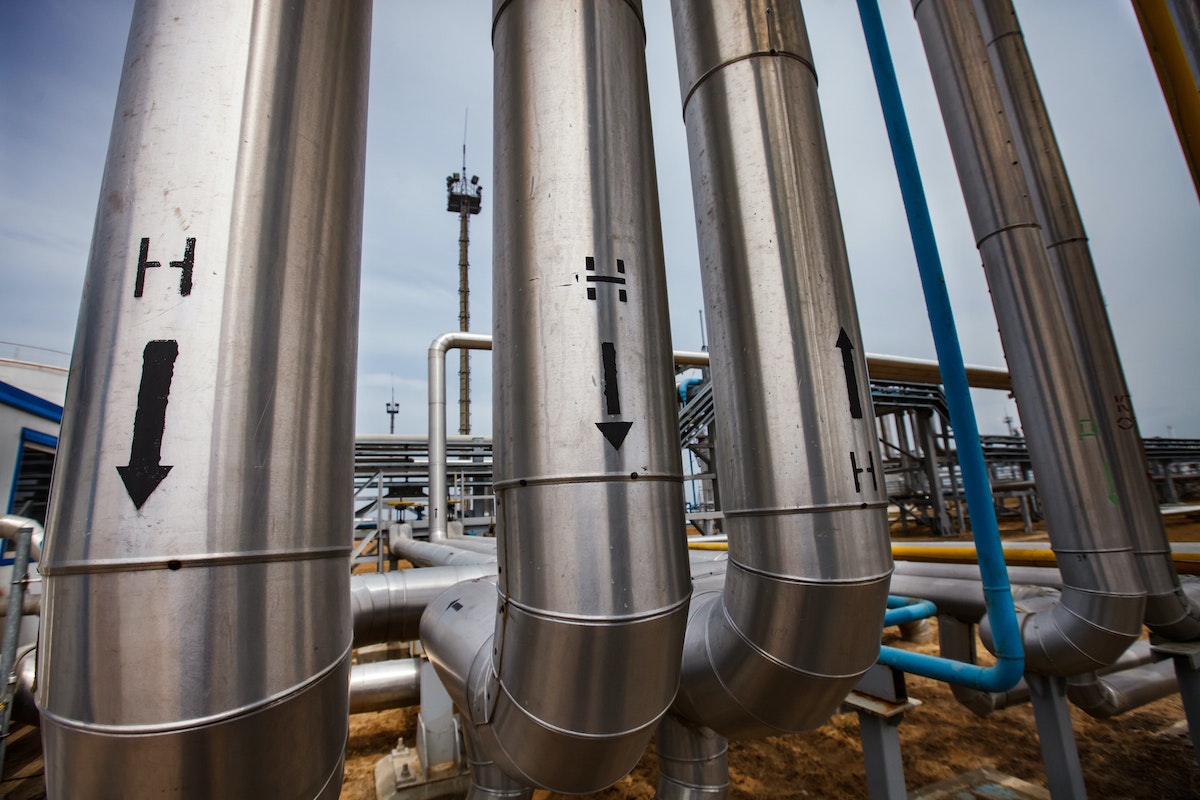
-
-
Share
-
Share via Twitter -
Share via Facebook -
Share via Email
-
Executive Summary
In theory, adding ammonia to the coal burned in a coal-fired power plant or adding hydrogen to the gas burned in a gas-fired power plant can reduce the fossil fuel emissions of coal and gas electricity production by a percentage equal to the fraction of ammonia or hydrogen in the fuel mix. This technique is called co-firing, co-burning, or co-combustion.
Current proposals to replace 20% of the heating value of coal burned in coal power plants with ammonia, for instance, would reduce direct power plant fossil carbon emissions by 20%. However, this emissions benefit is small, shrinking even further after considering the energy required to manufacture and transport ammonia and hydrogen fuel.
In the first place, co-firing of ammonia or hydrogen in a coal or gas plant at a 20% or 30% fraction still leaves 80% to 70% of the fossil fuel emissions associated with that power generation. Furthermore, compression and liquefaction of hydrogen for transoceanic shipping require significant electricity inputs, while 10% to 20% of the hydrogen cargo may disappear via losses during a long sea voyage. Finally, if suppliers produce the ammonia and hydrogen using fossil fuels, ammonia and hydrogen co-combustion in fossil power plants can actually result in considerably more carbon emissions than if the power plants were to burn only pure coal or natural gas (Figures 1 and 2).
Yet such problematic issues have not stopped many governments across Asia from pursuing ammonia and hydrogen co-combustion as part of national climate policies. Japan, Korea, and Singapore currently aspire to demonstrate co-burning of ammonia and hydrogen in coal- and gas-fired power plants within the next decade. Subsequently, these governments, joined by countries like Taiwan, envision ambitious increases in co-combustion in the thermal power sector in the 2030s and beyond. Numerous countries across Southeast and South Asia like Indonesia, Vietnam, and Malaysia are watching these technical and policy developments with interest, and have signed memoranda of understanding to research domestic co-firing potential. This regional push to achieve large-scale co-combustion in fossil power plants threatens to drive vast ammonia and hydrogen production in exchange for minimal climate benefits at best, with a strong risk that such policies ultimately increase emissions globally.
Ammonia and hydrogen co-firing in fossil power plants produces minimal climate benefit
Figure 1: Japan coal power sector emissions for different co-firing scenarios
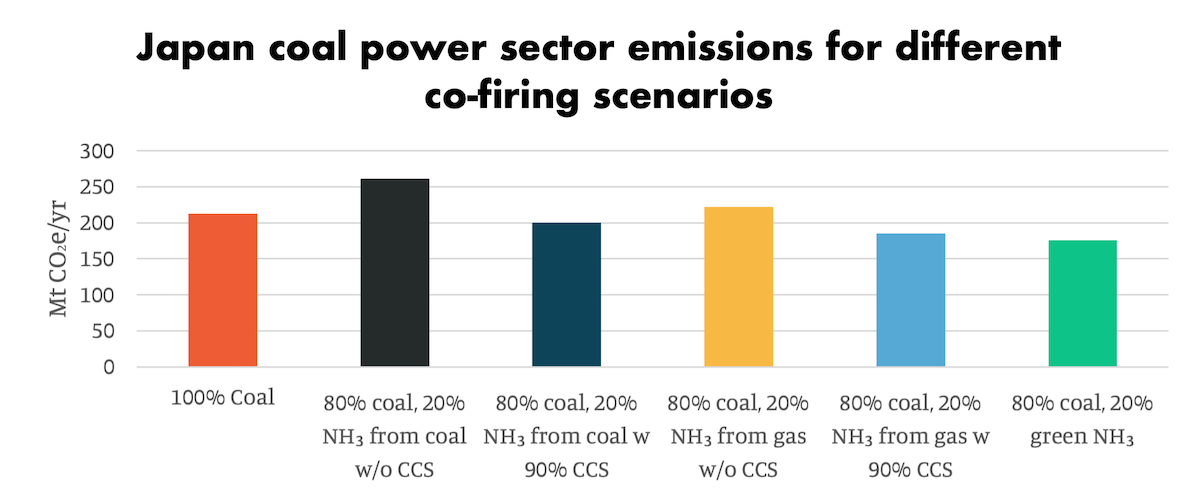
Figure 2: Japan gas power sector emissions for different co-firing scenarios
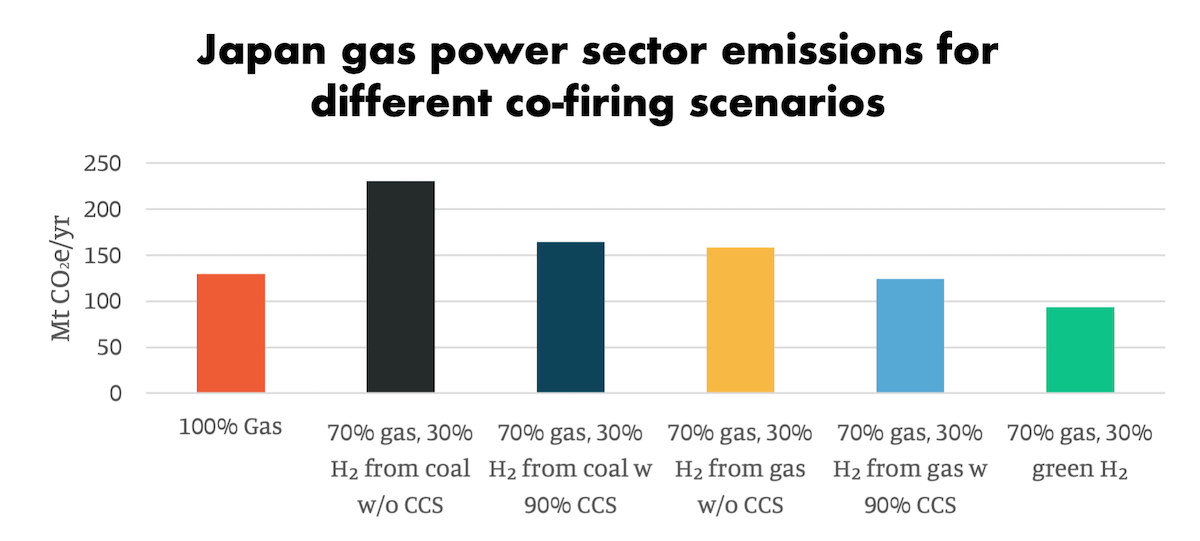
Many early pilot initiatives are explicitly sourcing hydrogen and ammonia from fossil fuels via elaborate international supply chains (Figure 3), with only vague long-term commitments to shift towards lower-carbon production using carbon capture or clean electricity. For example, the Japanese government recently committed a further US$1.6 billion (AUD$2.35 billion) to support development of a coal-to-hydrogen project in Australia’s Latrobe Valley. A similar project in Brunei has seen Japanese conglomerates working to source hydrogen shipments derived from fossil gas. Japan’s 5th Strategic Energy Plan, released in 2018, directly stated that Japan would seek to develop international hydrogen supply chains by making use “of cheap overseas fuels, including brown coal.” The succeeding 6th Strategic Energy Plan, published in 2021, removes the direct reference to brown lignite coal, but continues to prioritize “inexpensive hydrogen produced overseas.” That plan envisions hydrogen and ammonia co-combustion supplying 1% of national power generation by 2030 and rapidly scaling up thereafter.
Similarly, Korea’s 2019 Hydrogen Economy Roadmap outlines the importation of “overseas hydrogen produced with renewable energy and brown coal in an eco-friendly way” starting from 2030. Korea’s First Basic Plan for Transition to Hydrogen Economy envisions hydrogen providing 23.8% of national electricity generation by 2050. Taiwan’s president has stated a goal of producing 10% of the country’s electricity from hydrogen by 2050. Singapore is also seeking to demonstrate hydrogen co-firing in domestic gas-fired power plants.
Increasingly, environmental journalists and local and international advocacy groups are calling attention to the highly questionable climate merits of current power sector hydrogen policies. Other reporting on these early supply chain investments now highlights criticism of these projects and their claimed climate benefits, although some reports still take such allegations of sustainability at face value.
Figure 3: Upstream supply chain for hydrogen and ammonia
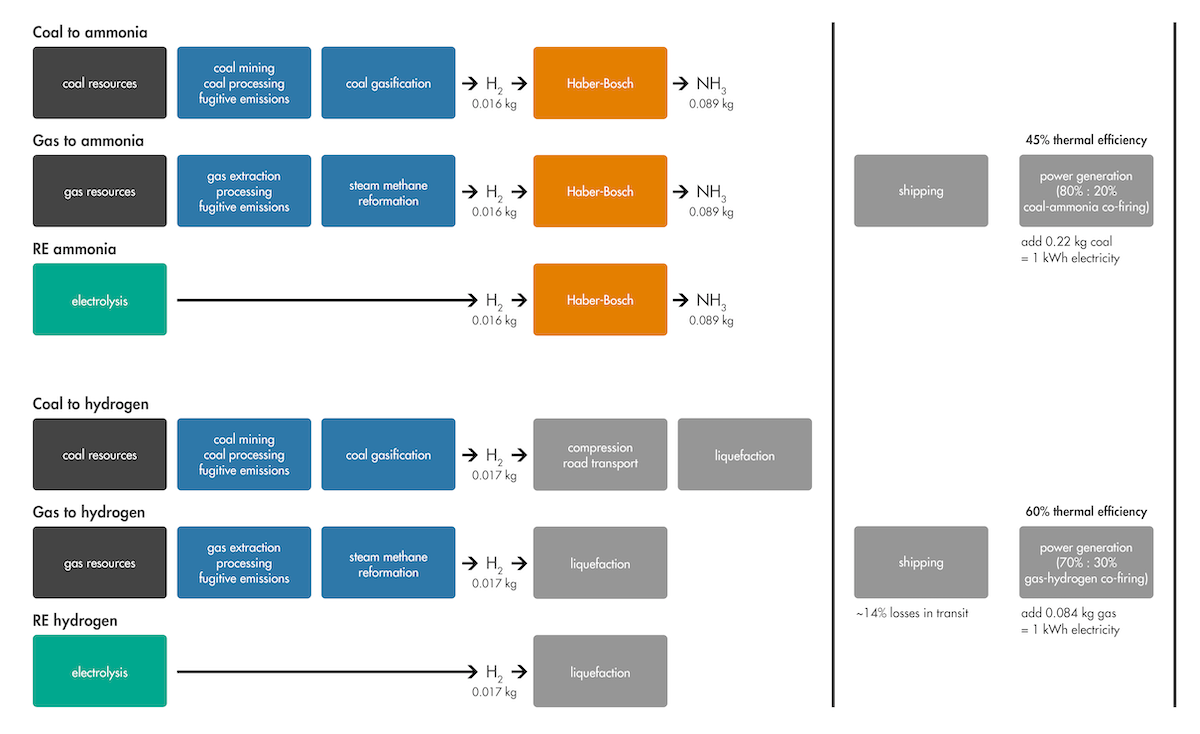
In this report we highlight the significant fossil fuel emissions concerns associated with fundamentally irresponsible hydrogen and ammonia co-firing policies and explain the major difficulties involved in supporting large-scale international ammonia and hydrogen trading for such wasteful end uses. Regional ambitions for ammonia and hydrogen co-combustion in thermal power plants are indicative of much larger problems in national hydrogen policies that envision broad economy-wide hydrogen use, including in likely economically uncompetitive sectors from light-duty transportation to domestic heat. Such overambitious plans are in all probability grossly overestimating the role of clean hydrogen in a future low-carbon economy.
We therefore also present policy recommendations and guiding principles that policymakers across East Asia should incorporate moving forward to help them redesign national hydrogen policies for greater efficiency, practicality, and sustainability.
Summary of Recommendations:
- Policymakers should abandon impractical and economically uncompetitive hydrogen end uses such as hydrogen and ammonia co-firing for thermal power, light-duty fuel cell vehicles, and hydrogen boilers for domestic heating. These policy improvements will require governments to scale back regional aspirations for large-scale hydrogen imports and widespread domestic hydrogen use.
- Clean energy policies must consider how hydrogen and ammonia co-firing in fossil power plants risks significant emissions increases if fossil fuel feedstocks are used to produce the hydrogen and ammonia.
- Policymakers must weigh alternative uses of clean hydrogen and ammonia. Even with best-case, low-carbon hydrogen and ammonia production, co-firing yields only minimal climate benefits and is a wasteful use of valuable low-carbon hydrogen and ammonia. We calculate that the amount of clean ammonia to support co-firing at a 20% fraction in Japan’s coal sector would be sufficient to help decarbonize 18% of the global ammonia fertilizer industry.
- Governments should prioritize greater domestic production of low-carbon hydrogen products, as extensive reliance on imported hydrogen and ammonia presents supply chain risks and involves high-cost investments in supply chain infrastructure.
- Policies should selectively and strategically target more technologically competitive hydrogen and ammonia end uses in sectors and applications where few to no viable decarbonization alternatives exist, such as chemicals, steelmaking, marine shipping, and seasonal energy storage.
- Public sector innovation efforts should also prioritize regional industry leadership in the technology provider role, by driving the development of key technologies like fuel cells, hydrogen turbines, electrolyzers, storage systems, and similar equipment.
- The strong regional interest in ammonia and hydrogen for thermal power generation highlights an underlying requirement for clean, firm, and/or flexible electricity generation assets across East Asia that can support increasing deployment of solar, wind, and storage technologies. As such, policymakers should invest judiciously in more practical alternatives for providing clean, firm power alongside variable renewable generation, including nuclear energy, gas with carbon capture, and geothermal energy.
Hydrogen co-firing for electricity will struggle to scale
How much ammonia and hydrogen would be required to displace a sizable fraction of coal and gas in East Asia’s thermal power sector?
Existing medium-term goals for electricity generation from hydrogen in the 2030s and 2040s remain poorly defined in the hydrogen policies of Japan, Korea, Taiwan, and other countries across the Asia-Pacific region. However, these countries’ shared interest in co-firing of imported ammonia and hydrogen in existing thermal power plants warrants concern given that thermal power is a particularly high-volume application for ammonia and hydrogen relative to its societal benefit. Even co-firing ammonia and hydrogen with coal and liquified natural gas (LNG) at low fractions to a moderate extent throughout the Asia-Pacific would represent vast growth in transoceanic trade of both commodities while only marginally decarbonizing the coal and gas power plants employing co-combustion. In fact, the added logistical needs of transoceanic importation could reverse such marginal emissions benefits altogether, leading to an increase in overall emissions.
We assess the energy and climate implications of high regional adoption of ammonia and hydrogen co-combustion in thermal power plants by evaluating the alternative fuel demand, energy footprint, and CO2 emissions associated with co-burning ammonia and hydrogen at significant fractions in Japan’s power sector.
We quantify the following values:
- Ammonia sufficient to support co-firing at a 20% ratio by heat fraction across Japan’s entire coal power sector in 2030.
- Hydrogen sufficient to support co-firing at a 30% ratio by heat fraction across Japan’s entire gas power sector in 2030.
The milestones we assess are far more ambitious than Japan’s current stated co-combustion policy targets. Rather, they represent a useful approximation of potential future large-scale thermal power demand for hydrogen and ammonia across the region as a whole.
In 2030, Japan’s Ministry of Economy, Trade, and Industry currently anticipates electricity generation there to decline to 934 TWh/yr, with coal and gas supplying 26% (243 TWh) and 27% (252 TWh) of power, respectively. However, we consider growth in electricity demand associated with higher-than-expected adoption of electric vehicles (5 million electric vehicles of various classes operating throughout the Japanese economy by 2030), and we assess further energy efficiency improvements more conservatively, given that long-standing national efforts in this area may yield diminishing returns to further energy efficiency efforts.
Therefore, we consider a scenario in which annual Japanese domestic electricity generation declines to 984 TWh/yr relative to its present-day level of 1065 TWh/yr. Without any co-firing, assuming thermal plant efficiencies of 45% for ultra-supercritical coal plants and 60% for modern combined-cycle natural gas plants, Japan would need to burn the following quantities of coal and gas annually.
Estimated Japanese power sector annual coal and LNG demand in early 2030s, without co-firing:
- 70.5 million metric tons of coal
- 23.4 billion cubic meters of gas (31.9 million metric tons LNG)
Co-burning of ammonia to replace 20% of this coal demand by heat fraction and co-burning of hydrogen to replace 30% of this gas demand by heat fraction would correspond to the following volumes of ammonia and hydrogen.
Estimated annual ammonia and hydrogen requirements to support co-firing:
- 22.7 million metric tons of ammonia
- 4 million metric tons of hydrogen
- In practice, the exporting country must produce ~4.65 million metric tons of hydrogen to meet supply requirements due to losses in shipping.
For comparison, global production of ammonia in 2019 totaled 182 million tons, while global hydrogen consumption in 2021 totaled 94 million tons.
This calculation illustrates the costly decarbonization trade-off inherent in ammonia and hydrogen co-firing. If we assume that all of this fuel supply is truly low-carbon “green” ammonia, for instance, this magnitude of clean ammonia production would be capable of fully eliminating emissions for around 18% of the global fertilizer industry (which represents ~70% of the ammonia market). In comparison to co-firing, which only marginally reduces fossil thermal power emissions (see Section 2 below), directing clean hydrogen towards clean fertilizer production is far more productive.
Producing the abovementioned 22.7 million metric tons of ammonia and 4 million metric tons of hydrogen requires 204 TWh and 283 TWh of low-carbon electricity, respectively (Figure 4). Assuming that Australia is the exporting country, it would need to multiply its existing renewable electricity generation eight times over, nearly tripling national electricity generation in order to supply these volumes of hydrogen and ammonia. This expansion would undoubtedly increase the difficulty of Australia’s own transition to clean electricity.
Figure 4: Energy required to produce hydrogen and ammonia for co-burning
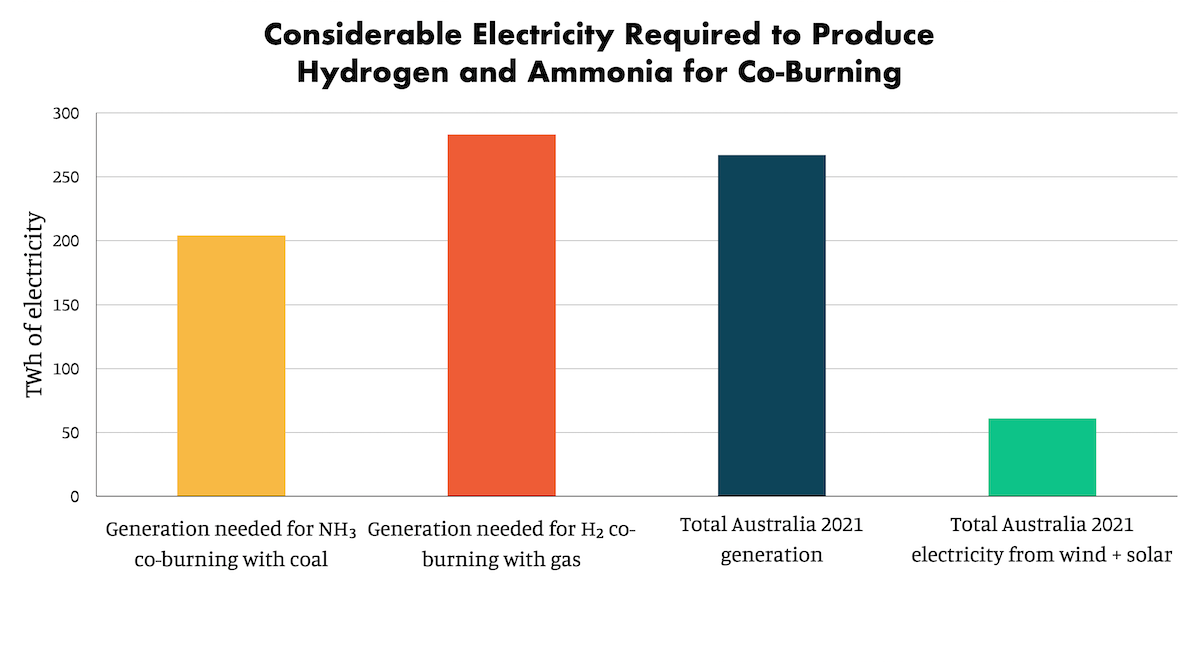
If countries like Taiwan, Korea, and Japan also plan to import additional large quantities of hydrogen for use in transportation and industrial sectors, while incurring losses of 10-20% during transoceanic shipping, the requisite expansion of clean electricity capacity in hydrogen-exporting countries will become even more substantial, likely driving up the cost of hydrogen imports.
Given such practical constraints on the degree to which exporting countries can produce clean hydrogen and ammonia at large scale, prospective importing countries should prioritize clean hydrogen for use in difficult-to-decarbonize sectors first and foremost. The international hydrogen and ammonia trade cannot realistically expand infinitely to accommodate both thermal power co-firing, low-carbon fertilizer, and other industrial uses like petrochemicals and steelmaking, in addition to widespread use in road vehicles and even hydrogen fuel cells for buildings.
In addition to the many challenges that complicate large-scale production in the exporting country, the envisioned vast regional trade in hydrogen and ammonia would also require significant and expensive investments in supply chain infrastructure and power plant equipment retrofits. This expansion would include hydrogen and ammonia export and import facilities, specialized vessels to ship these fuels overseas, storage tank and pipeline infrastructure, and modifications to power plant boilers, fuel injection systems, and steam turbines. The high costs of such complex infrastructure networks, which will likely result in increased energy costs for downstream consumers, may produce serious national economic risks.
In short, the co-firing of even small fractions of hydrogen and ammonia in existing thermal power plants requires the buildout of an extremely expensive and specialized infrastructure network at considerable regional scale. Such questionable policy-driven investments are even more problematic given that hydrogen and ammonia imports for thermal power co-firing may not be low-carbon at all.
Hydrogen co-firing for electricity will not meaningfully reduce emissions
Preliminary projects to supply international hydrogen markets in the Asia-Pacific use fossil fuel feedstocks to produce hydrogen and subsequently synthesize ammonia. Hydrogen production from coal hydrocarbons or methane gas (CH4) inherently generates carbon dioxide for every unit of hydrogen yielded. These carbon emissions could be captured, yet currently operating and announced pilot projects in the region have made only vague, non-binding commitments to install carbon capture equipment at some later date. In the near term, unabated use of coal or gas as feedstock for ammonia and hydrogen production is unequivocally worse than simply burning coal or gas directly.
Meanwhile, ammonia or hydrogen produced from coal or gas using highly efficient carbon capture (“blue” hydrogen and ammonia) significantly shrinks the already-small climate benefit from co-firing, due to added supply chain and production emissions. Assuming a co-firing fraction of 20%, even with 90% carbon capture of ammonia production emissions, we calculate that ammonia produced from brown coal-derived hydrogen offers only a 6% emissions reduction (Figure 5). Ammonia produced from natural gas with 90% carbon capture in turn reduces coal power emissions by only 13%.
These benefits shrink even further and disappear entirely for fossil-derived hydrogen co-combustion, due to the significant added energy inputs required for hydrogen compression, liquefaction, and transportation. Even with 90% carbon capture at the production facility, hydrogen produced from lignite coal and co-burned in a gas power plant as 30% of the fuel mix will actually increase the emissions intensity of gas-fired electricity by 27% (Figure 6). Hydrogen from gas with 90% carbon capture produces an emissions reduction benefit of only around 4%.
Indeed, even in the absolute best-case scenario where hydrogen and ammonia are produced exclusively using low-carbon electricity, co-firing these fuels reduces the emissions intensity of fossil fuel electricity by only 27.7% and 17.5%, respectively.
Figure 5: Supply chain emissions of ammonia co-fired with coal for electricity
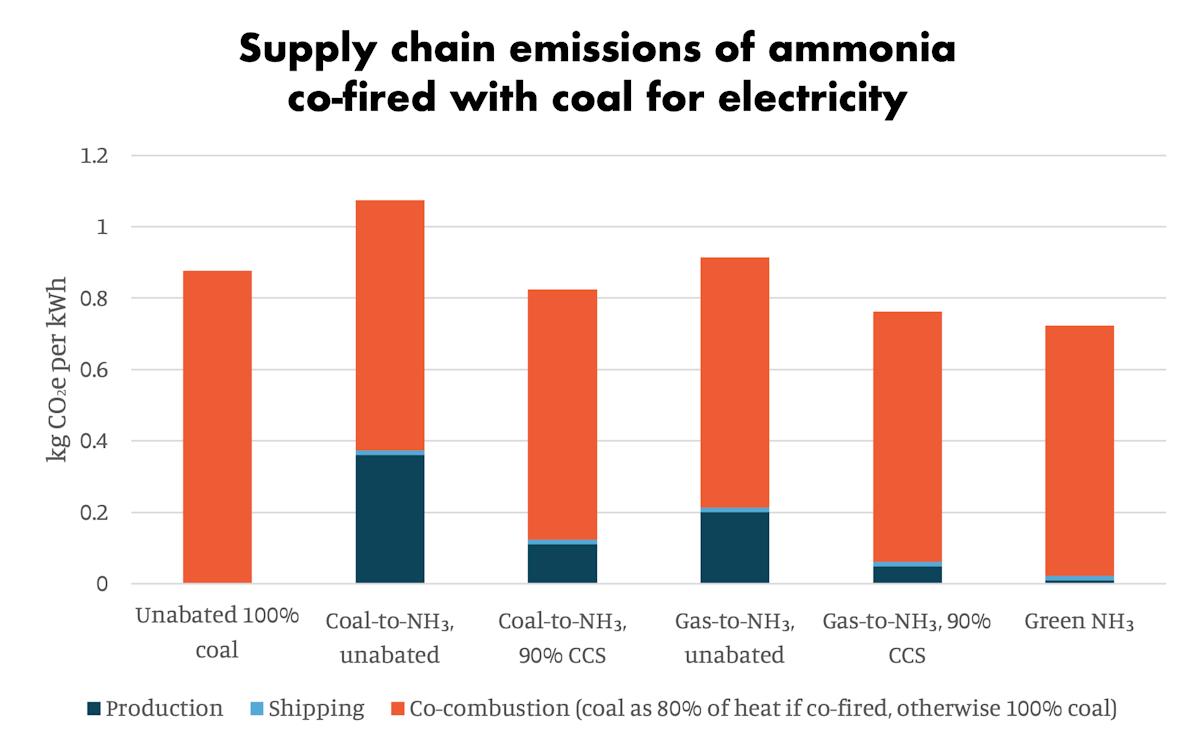
Figure 6: Supply chain emissions of hydrogen co-fired with gas for electricity
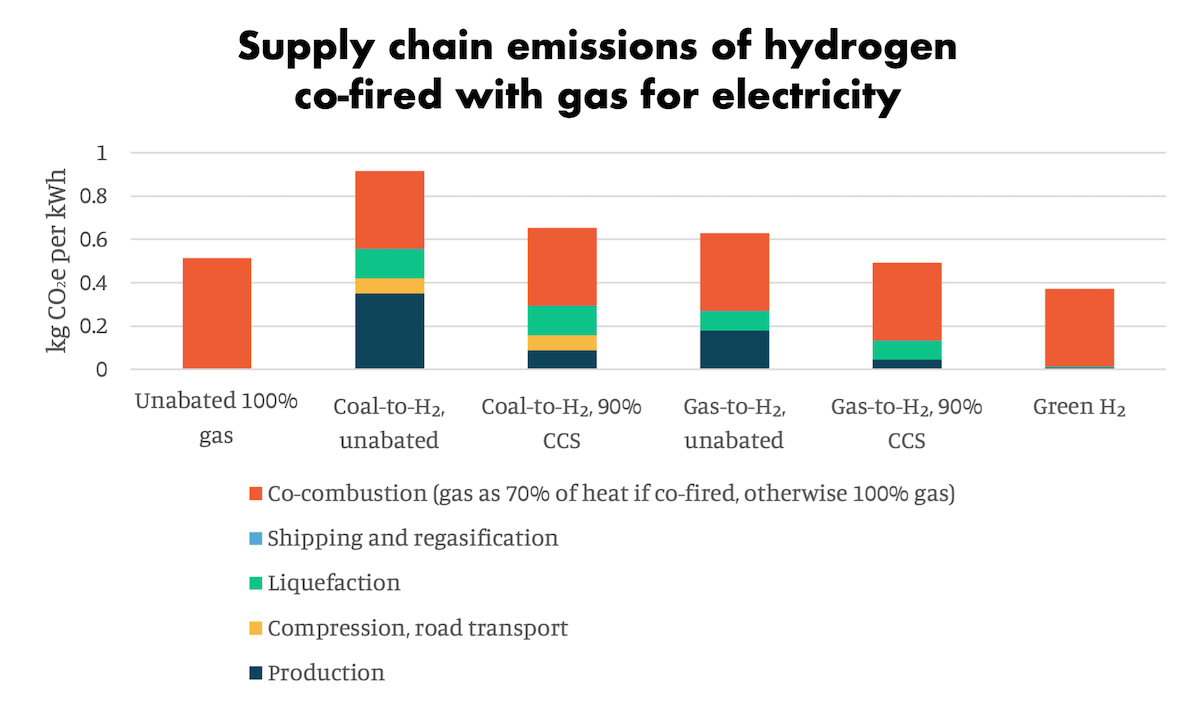
Some might argue that policymakers in Taiwan, Korea, Singapore, and Japan plan to progressively increase the fraction of hydrogen and ammonia co-firing in fossil power plants, raising the climate benefit of co-combustion over time. However, such plans still depend critically on the emissions intensity of hydrogen and ammonia production, while additionally involving large, long-term increases in the scale of hydrogen and ammonia imports with every increase in the co-firing percentage. Alternatively—or simultaneously—coal and gas plant operators would need to consider costly retrofits to capture emissions from the remaining fraction of fossil coal and gas burned. Furthermore, policies that depend on future commitments to further upgrade thermal power units create the risk that high capital and alternative energy costs will ultimately discourage fulfillment of such promises, leading to long-term procrastination and continued reliance on co-combustion at lower fractions of coal and gas replacement.
Needless to say, co-firing practices—particularly for coal plants—also prolong harmful environmental and public health effects that are not directly climate-related, like air pollution, coal ash waste, and ecological impacts from coal mining and processing. Analysis of ammonia co-firing with coal indicates that ammonia co-combustion may even increase the production of particulate air pollution pre-cursors, potentially exacerbating air pollution risks.
In summary, the viability of co-firing as part of national climate policy depends on absolutely perfect execution, including ambitious future efforts to transition ammonia and hydrogen production to truly low-carbon production methods. Anything short of flawless execution risks stalling emissions reductions or even increasing counterproductive emissions. It is unlikely that policymakers can guarantee such unmitigated success.
With these calculations and considerations in mind, it is clear that current policies in Japan and Korea that allow for the possibility of producing hydrogen or ammonia from fossil fuel feedstocks are not true climate solutions. Furthermore, these policies are likely to be cost-prohibitive in practice, significantly raising the cost of thermal power production with the risk of large increases in national electricity prices. A BloombergNEF analysis calculated that ammonia co-firing for coal thermal power plants would not be economical without a carbon price of at least US$300/ton by 2030, with other research indicating that 20% ammonia co-firing could double fuel costs for units practicing co-combustion. Given that countries like Taiwan, Korea, and Japan have economies with vibrant advanced technology and manufacturing sectors that depend on electricity inputs, reliance on large-scale hydrogen supplies in the thermal power sector may come with broader serious economic risks.
In the following section, we propose recommendations that can guide policymakers across East Asia towards the development of more realistic, efficient, cost-effective, and beneficial domestic hydrogen strategies.
East Asian governments must reconsider hydrogen co-firing goals and revise hydrogen policies
Importation of overseas hydrogen and ammonia sourced from fossil feedstocks, even if produced with efficient carbon capture, has no place in legitimate climate policy.
Coal-to-hydrogen and gas-to-hydrogen projects announced in Australia and Southeast Asia do not currently utilize any carbon capture technology at all, resulting in hydrogen and ammonia products with a considerable carbon footprint (Tables 1-3). Yet even if such projects were to incorporate highly efficient carbon capture technology, any produced hydrogen and ammonia will offer only a reduced margin of emissions reductions relative to pure fossil fuels, particularly if co-fired with fossil fuels for electricity (see Figures 4-5). This is because production and supply chain emissions associated with fossil fuel extraction, incomplete carbon capture, storage and transportation, loss of product, and fugitive methane emissions add significantly to the carbon impact of fossil fuel-derived hydrogen and ammonia (see Figure A1 in Appendix).
We further point out that under any conceivable or proposed international frameworks and standards for clean hydrogen and ammonia, it will be difficult for blue hydrogen or ammonia produced with carbon capture to qualify as low carbon. As such, policymakers should strongly reconsider costly investments in fossil-derived hydrogen and ammonia production that may not ultimately count at all towards national climate progress.
Table 1: Emissions intensity of ammonia production in Australia using either hydrogen sourced from fossil gas or from electrolysis using clean electricity

Table 2: Emissions intensity of ammonia production in Australia using hydrogen sourced from coal

Table 3: Emissions intensity of hydrogen production in Australia using hydrogen sourced from coal

Policymakers should shift hydrogen policies away from uncompetitive, impractical hydrogen end uses.
Governments should adopt narrower visions for the future hydrogen sector that eliminate uncompetitive applications such as hydrogen and ammonia co-firing in thermal power plants, hydrogen-based light-duty transportation, or hydrogen for residential heating. In particular, widespread use of hydrogen in the thermal electricity sector is likely to be far less economical than other available low-carbon technologies such as wind, solar, nuclear, or geothermal power. Similarly, rapid technological progress in battery electric vehicles has given them considerable advantages over hydrogen fuel cell automobiles, while electric heating and heat pumps are also technically superior and more cost-efficient than hydrogen boilers for home heating applications. Heavy investment in hydrogen-based power, transportation, and heating would further require costly, risky, large-scale infrastructure investments while continuing the region’s historically heavy reliance on transoceanic energy imports.
The clear unsuitability of hydrogen for power generation, light-duty transportation, or home heating at large scales highlights the need for policymakers to scale back unrealistic visions for a Hydrogen Society or Hydrogen Economy. Without large sectors like power, transportation, and heating driving significant hydrogen demand, future national hydrogen consumption is likely to be far smaller and narrower than current policies anticipate, with hydrogen primarily used in specific industrial applications and only employed as a niche, supporting fuel in the electricity and transportation markets.
Policies should elevate the priority of domestic clean electricity generation and hydrogen production.
The uncompetitiveness and practical drawbacks of fuel cell vehicles and hydrogen and ammonia co-firing in thermal power plants in turn mean that Japan, Korea, and Taiwan will need to redouble efforts to deploy domestic clean electricity generation capacity to support power sector decarbonization alongside added electricity demand from the transportation and building sectors. Land-constrained countries like Singapore may alternatively need to invest in international transmission interconnections to import sufficient quantities of clean power from neighboring states.
At the same time, reliance on international transoceanic hydrogen imports for remaining hydrogen end uses in sectors like heavy industry, chemicals, and heavy transportation necessarily involves supply chain inefficiencies resulting from energy-intensive liquefaction, chemical conversions, and losses during shipping. Added domestic clean hydrogen production may consequently offer some economic advantages compared to overreliance on imported hydrogen from abroad. As such, policymakers should continue to pursue domestic research, development, and commercialization of hydrogen electrolyzer technologies, while also accounting for the added domestic power generation resources needed to support local hydrogen production.
Updated, effective hydrogen policies should strategically and selectively target key sectors.
Meanwhile, policies like investment tax credits for seeking to develop hydrogen end uses should prioritize more competitive applications for clean hydrogen, particularly sectors that possess few technological alternatives for decarbonization. Tax incentives would be well suited to target projects and infrastructure for low-carbon ammonia fertilizer production, low-carbon chemicals and fuels, hydrogen-based iron ore reduction, heavy industrial process heat, and heavy-duty transportation and shipping.
At the same time, hydrogen policies across East Asia could leverage the region’s strengths in advanced technology development to pursue strong positions as key future hydrogen technology providers. For instance, worldwide demand for cutting-edge equipment such as electrolyzers, hydrogen turbines, fuel cells for heavy vehicles, hydrogen-carrying vessels, and liquefaction and storage facilities can be expected to increase over the coming decades. Rather than investing extensively in expensive supply chain infrastructure to accommodate a risky and overly ambitious vision for domestic hydrogen demand, governments can concentrate public sector support on such technology growth sectors. Securing hydrogen technology leadership will generate a more certain return on public investment and foster longer-term innovation and economic activity.
Power sector policies should prioritize alternative technologies for firm and/or flexible clean generation.
From Japan to Korea to Taiwan, the common emphasis on thermal electricity production from low-carbon hydrogen and ammonia arguably highlights a shared interest in low-carbon, firm, dispatchable sources of electricity generation to complement growing use of variable renewable energy sources. As discussed throughout this report, co-firing of hydrogen and ammonia for thermal power generation is unlikely to produce meaningful climate benefits, faces difficulties related to the scale and cost of hydrogen and ammonia supplies, and may risk increasing electricity sector emissions if fossil fuels are employed as the feedstock for hydrogen production. Rather than pursuing such a questionable and speculative vision for extending the lifetime of existing fossil power plants, policymakers should shift their focus towards development of alternative flexible, low-carbon power plant technologies—namely, nuclear power, geothermal energy, and advanced carbon capture, which can in turn support more ambitious efforts to install new renewable energy capacity and storage.
Recent developments in next-generation nuclear and geothermal power plant design offer improved versatility, flexibility, and economic viability and may start to achieve wider commercial deployment by 2030. Geothermal energy potential in Korea, Japan, and Taiwan is considerable, while smaller advanced nuclear reactors offer significantly improved safety characteristics and can be flexibly sited to optimize usage of scarce land and match power system needs. Both geothermal and advanced nuclear power plants also offer the potential to ramp up quickly and store and discharge thermal energy to regulate the electricity supply in conjunction with variable renewable generation, facilitating faster deployment of domestic wind and solar resources. Meanwhile, carbon capture technology faces cost-related challenges and must attain a high rate of carbon capture efficiency to produce a meaningful climate benefit, but emerging carbon capture power plant designs such as Allam Cycle gas-fired generation may be able to overcome such challenges and are also worth considering.
Future Outlook
As advanced economies with medium-sized populations and extensive administrative systems, countries like Taiwan, Korea, and Japan can leverage some degree of strong state capacity to propel national transitions towards low-carbon energy. However, the extent of what state capacity can accomplish is not limitless.
As such, policymakers in the Asia-Pacific region must strategically and judiciously choose which technologies, policies, and economic sectors to prioritize as they seek to balance national climate policies and economic goals. Looking ahead makes it clear that persistent pursuit of hydrogen and ammonia co-firing in fossil power plants is both a risky technological strategy and an ineffective climate strategy. More broadly, Japan and Korea have continued to entertain unusually broad domestic visions for an expansive future hydrogen economy that spans low-carbon power, transportation, industry, and heating. Such aggressive policies diverge from decarbonization strategies elsewhere around the world, which are increasingly excluding economically non-competitive hydrogen end uses in light vehicles, individual heating, and thermal electricity generation. Meanwhile, efforts to promote ammonia and hydrogen co-firing technology throughout Southeast Asia risk economic, environmental, and emissions consequences beyond the region.
To stubbornly adhere to existing hydrogen policies that chiefly promote thermal power and light-duty transportation is to risk committing costly policy mistakes. Rather, East Asian policymakers must acknowledge two emerging paradigms of the region’s low-carbon energy transition.
First, alternatives to hydrogen technologies—such as electric vehicles and heat pumps—are achieving increasing adoption worldwide and are expected to outcompete fuel cell vehicles and hydrogen boilers. This trend means that governments should anticipate the need to invest in additional domestic electricity generation, rather than the means to support vast transoceanic hydrogen import volumes. Second, this increasing importance of the power sector highlights the significance of investing in viable firm or flexible low-carbon technologies that can complement ambitious national programs to expand variable renewable generation capacity.
Ammonia and hydrogen co-firing has no future. As such, policymakers in the Asia-Pacific must urgently prioritize alternatives that can provide the same flexible, reliable roles in the electricity system. Meanwhile, low-carbon hydrogen will undoubtedly play important but more limited roles in decarbonizing sectors like heavy-duty transportation and industry. A well-executed shift of existing national hydrogen strategies to target these more competitive applications will leverage public spending far more efficiently. In turn, smarter power sector and hydrogen policies will produce greater economic benefits, thanks to lower energy costs, less reliance on international energy imports, and refocused efforts to achieve leadership in more viable, promising clean energy technologies.
Reviewers: Katrine Petersen, Hanna Hakko, Nathan Iyer
Data Appendix
Table A1: Assumed lower heating values for various fuels

Table A2: Energy inputs required for ammonia production in Australia using either hydrogen sourced from fossil gas or from electrolysis using clean electricity

Table A3: Assumed carbon intensity of electricity generation from selected technologies and supply chain steps.
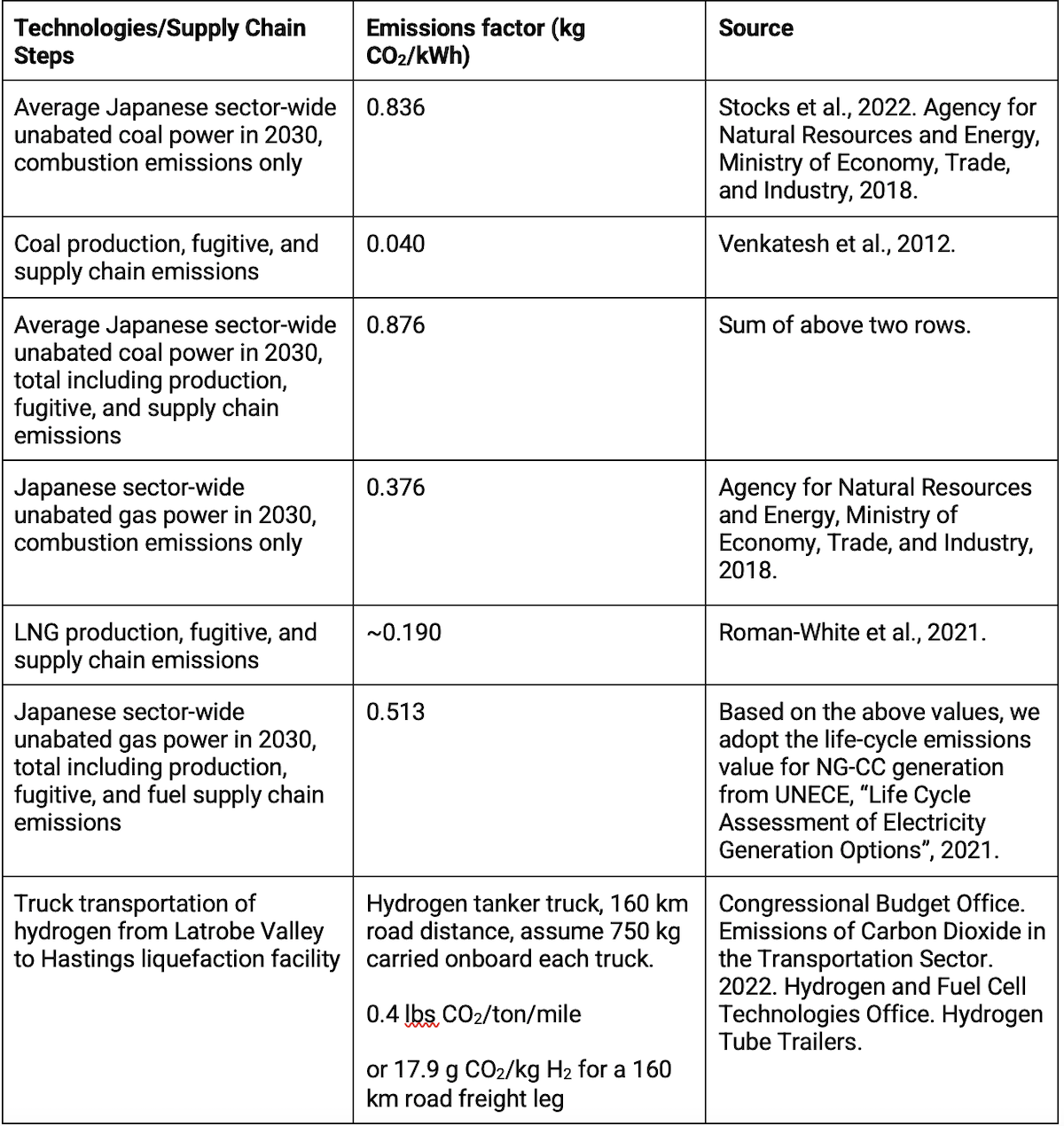
Figure A1: Production, supply chain, and combustion emissions for ammonia co-firing in coal power plants for ammonia produced from different methods and feedstocks
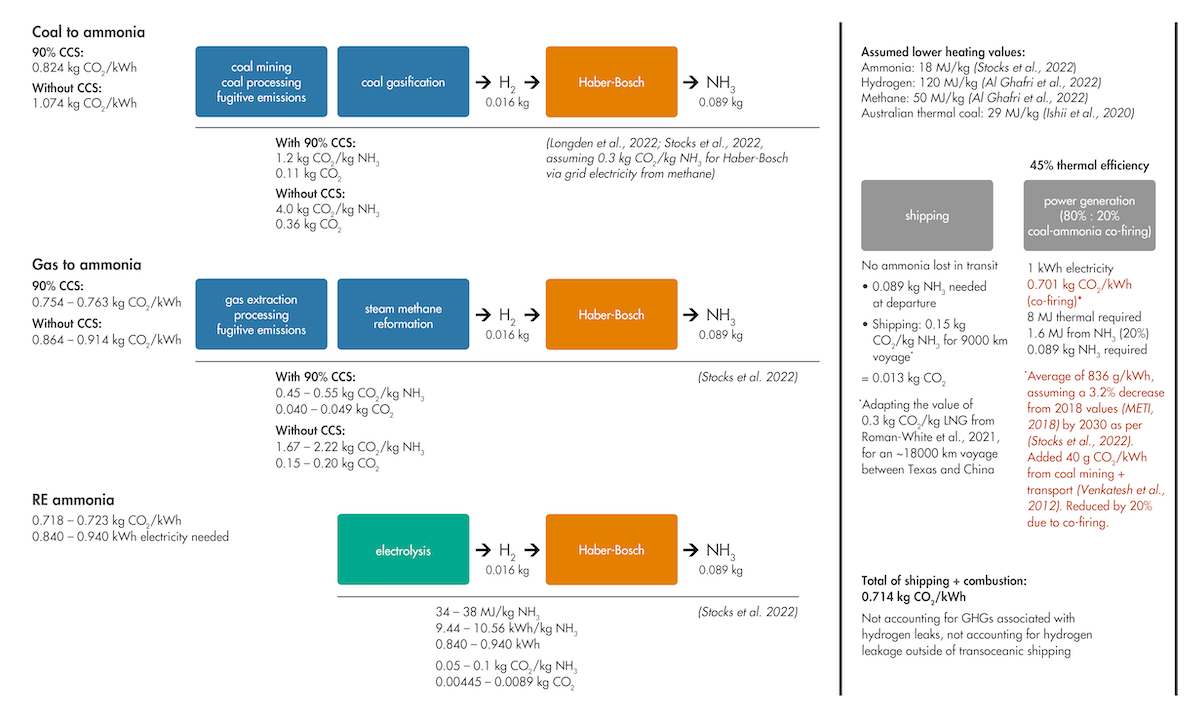
Figure A2: Production, supply chain, and combustion emissions for hydrogen co-firing in fossil gas power plants for hydrogen produced from different methods and feedstocks
